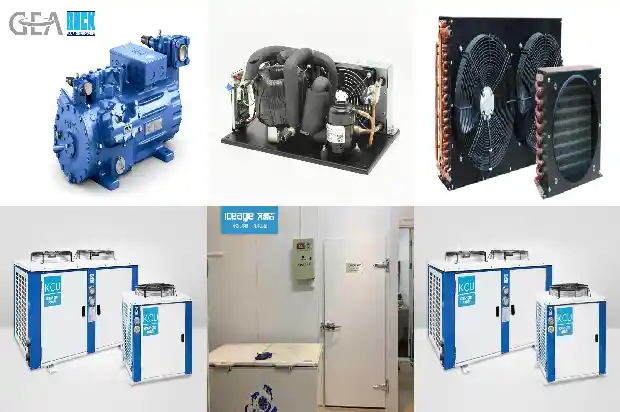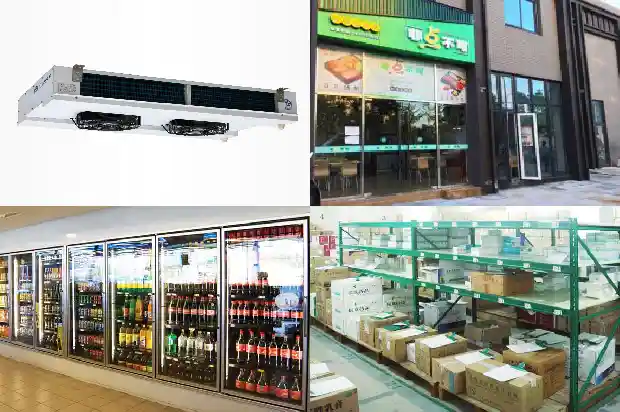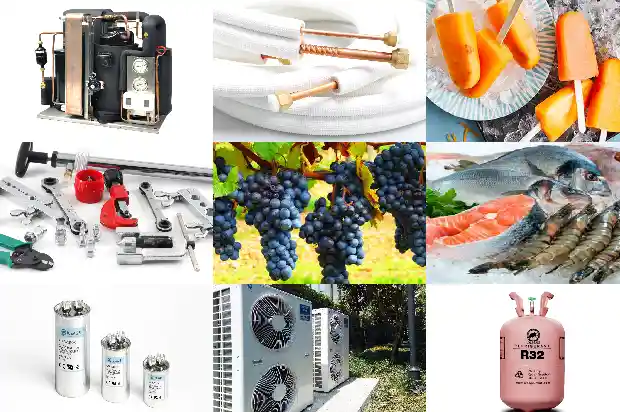Performance Comparison of Multi - connected Units, Air - cooled Modules and Water - cooled Screw Units
2025-03-04
The models for this performance comparison of central air conditioners are:
Modular air - cooled chiller (heater) water units;
VRV variable frequency multi - connected units;
Screw chiller units.
Modular air - cooled chiller (heater) water units;
VRV variable frequency multi - connected units;
Screw chiller units.
I. Modular Air - cooled Chiller (Heater) Water Units
The air - cooled modular chilled/hot water unit is a central air - conditioning unit that uses air as the cold (heat) source and water as the cooling (heating) medium. As an integrated device for both cooling and heating, the air - cooled modular chilled/hot water unit omits many auxiliary components such as cooling towers, water pumps, boilers, and the corresponding pipeline systems. It has a simple system structure, requires a small installation space, is convenient for maintenance and management, and saves energy, making it widely applicable. Therefore, the air - cooled modular chilled/hot water unit is usually suitable for HVAC projects that have neither a heating boiler nor a heating pipeline network or other stable and reliable heat sources but require air conditioning throughout the year. It is a preferred solution in the design.
The centralized and semi - centralized central air - conditioning system composed of the main unit, fan coil units, air handling units, and other terminal devices has the characteristics of flexible layout and diverse control methods. It is especially suitable for use in shopping malls, hospitals, hotels, factories, office buildings, and other places. The air - cooled modular chilled/hot water unit is equipped with standard water pipe interfaces and unit combination control functions, enabling the unit to operate smoothly. After installation, it can be used by connecting the power supply and water pipeline. When it is necessary to increase or decrease the main unit due to the increase or decrease of the air - conditioning area, its convenience is even more prominent.
Advantages:
The centralized and semi - centralized central air - conditioning system composed of the main unit, fan coil units, air handling units, and other terminal devices has the characteristics of flexible layout and diverse control methods. It is especially suitable for use in shopping malls, hospitals, hotels, factories, office buildings, and other places. The air - cooled modular chilled/hot water unit is equipped with standard water pipe interfaces and unit combination control functions, enabling the unit to operate smoothly. After installation, it can be used by connecting the power supply and water pipeline. When it is necessary to increase or decrease the main unit due to the increase or decrease of the air - conditioning area, its convenience is even more prominent.
Advantages:
- The initial equipment investment is about 15% cheaper than that of the variable frequency multi - connected (VRV) units.
- It has a large cooling capacity adjustment range and can achieve step - wise or stepless adjustment.
- The technology is mature, the service life is long, and there is no need for a dedicated machine room. It can be directly installed on the roof or in an outdoor space.
- The system structure is simple, and the installation space is small, especially suitable for areas lacking water sources.
- It saves large auxiliary equipment or accessories such as cooling towers, water pumps, boilers, and the corresponding pipeline systems.
- It has two independent working systems, and a failure of one system will not affect the normal operation of the entire unit.
- The indoor air is cooled through water, keeping the relative humidity of the air within the range of human comfort.
Disadvantages: - In cold regions (such as Northeast China), electric auxiliary heating equipment needs to be configured during heating.
- It is necessary to conduct maintenance and equipment cleaning once a year.
II. VRV Variable Frequency Multi - connected Units
The full name of the VRV air - conditioning system is the variable refrigerant volume system. In terms of system structure, it is similar to a split air - conditioning unit. It uses one outdoor unit corresponding to a group of indoor units. In terms of control technology, it adopts a variable frequency control method, controlling the rotational speed of the scroll compressor in the outdoor unit according to the number of indoor units turned on, and controlling the refrigerant flow.
Compared with the all - air system, all - water system, and air - water system, the VRV air - conditioning system can better meet the personalized usage requirements of users. The building space occupied by the equipment is relatively small, and it is more energy - efficient. It is precisely because of these characteristics that it is more suitable for office building construction projects that require frequent independent overtime work.
Advantages:
Compared with the all - air system, all - water system, and air - water system, the VRV air - conditioning system can better meet the personalized usage requirements of users. The building space occupied by the equipment is relatively small, and it is more energy - efficient. It is precisely because of these characteristics that it is more suitable for office building construction projects that require frequent independent overtime work.

Advantages:
- The multi - connected unit system can automatically adjust the rotational speed of the compressor according to the change of the system load to change the refrigerant flow, ensuring that the unit operates with high efficiency. The energy consumption is reduced during partial load operation, and the annual operating cost is relatively low.
- The multi - connected unit system only has refrigerant pipes and condensate pipes, and the refrigerant pipes are flexibly arranged and convenient for construction. Compared with the central air - conditioning water system, under the condition of meeting the same indoor ceiling height, using the multi - connected unit system can reduce the building floor height and the construction cost.
- The construction workload of the multi - connected unit system is much smaller, and the construction period is short, especially suitable for project renovation. There are few system links, and all equipment and control devices are provided by the equipment supplier, making the system operation management safe and reliable.
- The multi - connected unit system is convenient and flexible to combine. It can organize the system according to different usage requirements to meet the usage requirements of rooms under different working conditions.
- It can be equipped with wired/wireless/centralized control/remote centralized monitor, with high temperature control accuracy; it has a self - diagnosis function for faults, and a simple and complete self - diagnosis function; during the operation of the equipment, there is no need for a dedicated person to maintain it, effectively reducing the equipment maintenance cost.

Disadvantages: - The equipment cost is high.
- The refrigerant exchanges heat with the air, resulting in a large temperature difference between the supply and return air, high air dryness, and poor comfort.
- The system has many connection points, which is likely to cause the leakage of Freon. At the same time, it will also form an ice blockage, hindering the circulation of the refrigerant and affecting the cooling (heating) of the unit.
- There are many systems, resulting in a large maintenance workload. Moreover, the refrigerant leakage is not easy to detect, and the maintenance difficulty is high.
III. Screw Chiller Units
The screw chiller unit is a high - efficiency and energy - saving air - conditioning cold source equipment developed after years of exploration and research, drawing on the latest research achievements in the engineering fields of automatic control, refrigeration, heat and mass transfer, multiphase separation, etc. at home and abroad. It has a variety of optional configurations such as large temperature difference, ice making and cold storage, heat recovery, and primary pump variable flow. Its comprehensive performance has reached the international advanced level and can meet various needs. It can not only provide chilled water for the central air - conditioning systems of places such as hotels, hospitals, pharmaceutical factories, theaters, gymnasiums, entertainment centers, commercial buildings, office buildings, industrial and mining enterprises, but also provide process chilled water for industries such as textiles, chemicals, food, electronics, and scientific research.
Advantages:
Advantages:
- It can have a high compression ratio, a high EER value, a wide energy coverage range, and users have a large choice.

- It can smoothly adapt to the change of the air - conditioning load through the slide valve adjustment, without surging phenomenon, with a low maintenance cost and a long motor life.
- It can be adjusted steplessly within the range of 10% - 100%, with high efficiency during partial load and significant power saving.
- It operates under positive pressure, and there is no problem of external air intrusion and corrosion.
- It is not sensitive to the wet stroke.
Disadvantages: - The price is relatively high.
- The lubricating oil system is relatively complex, and the oil consumption is large.
- The noise is high.
- The assembly accuracy is high, and the installation and debugging are complex.
- The later operation cost is high.
Related Articles
- Comparison of Performance of Three Common Refrigeration Compressors (Reciprocating, Screw, Centrifugal)
- Introduction to common cooling capacity performance coefficient and main parameters of water chillers
- Five potential reasons for the deteriorating performance of car air conditioning
- Performance of Eco-friendly Refrigerants 410A and R407C
- Comparison Issues between Air-Cooled Screw Units and Air-Cooled Modular Units
- Cost Comparison of Ammonia-to-Fluorine Conversion in Cold Storage Renovation
- Comparison of R22, R410A, R32 and R290
- Wiring Methods, Faults and Classifications of Fan Coil Units, All Here~~
- Screw Chiller Units and Centrifugal Chillers
- Matters Concerning the Installation of Parallel Units
- Advantages and Disadvantages of Air-cooled Multi-connected Units and Analysis of Their Components
- Cause Analysis of High Discharge Temperature and Overload Protection of Modular Units
- Screw Compressor Units: Principles, Design and Selection - Essential Guide for Refrigeration Beginners
- Refrigeration Components of Refrigeration
- Basic Faults and Preventive Maintenance of Water - cooled Units
- Winter Approaches: How to Solve the Low High - pressure Issue of Air - cooled Condensing Units?
- Common Pressure Valves and Protection Devices in Refrigeration Units
- How to Troubleshoot and Repair High - pressure Protection of Air - cooled Units?
